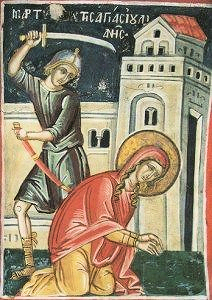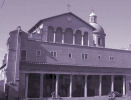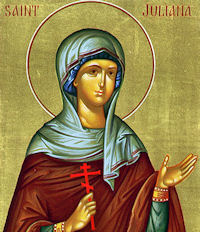Ordinary Time: February 16th
Monday of the Sixth Week of Ordinary Time
Other Commemorations: St. Juliana, Virgin and Martyr (RM)
» Enjoy our Liturgical Seasons series of e-books!
Now Jesus and his disciples set out for the villages of Caesarea Philippi. Along the way he asked his disciples, "Who do people say that I am"? They said in reply, "John the Baptist, others Elijah, still others one of the prophets." And he asked them, "But who do you say that I am"? Peter said to him in reply, "You are the Messiah." Then he warned them not to tell anyone about him (Mark 8:27-30).
Who Do Men Say that I Am?
The climax of all this preparation has an appearance of inevitability, when Christ puts the question at Caesarea Philippi, "Whom do men say that I am"? He seems only to be waiting for St. Peter's reply, in order to make the solemn declaration which stands at the center of St. Matthew's Gospel: "Thou art Peter, and upon this rock I shall build my Church." Yet the reply of St. Peter does not seem so very different from the words he had previously spoken at Capernaum.
At Caesarea Philippi, however, the words of St. Peter contain a meaning, which does not appear in his former declaration at Capernaum. Then he was speaking in the name of the other apostles, and reasserting the faith, which they had possessed from the beginning. But now he utters a simple declaration, whose deeper meaning is revealed in the response of Christ: "It is not flesh and blood, it is my Father in heaven who has revealed this to you." As, therefore, the Father has revealed the name of Christ to St. Peter, so it is now the turn of the Son to reveal the further significance of the name of Peter—not merely as rock, but specifically as that rock on which He intends to build His Church.
Here, if anywhere, would seem to be St. Peter's central experience of Christ, where in return for his naming of Christ he receives his own name of Peter. In his first meeting with Christ, according to the account of St. John, he had only received his name in promise: "Thou shalt be called Peter." But now he is called Peter in the present: "Thou art Peter."
Nevertheless, in what immediately follows, our minds are directed away from the present to the future, when Christ continues: "And on this rock I shall build my Church." Nor is the reason for this future tense difficult to discover. We have only to read a little further in the same Chapter Sixteen, to see how St. Peter is as yet conspicuously lacking in supernatural strength. In objecting to Christ's Prophecy of His coming Passion, he draws upon himself the terrible rebuke: "Get behind me, Satan; you are a scandal to me, for you taste not the things of God, but the things of men." This is indeed a striking contrast with what has gone before—no less, in fact, than the contrast between firm rock and shifting sand.
Excerpted from Homily 54 on the Gospel of Matthew, St. John Chrysostom.
St. Juliana of Nicodemia
 St. Juliana suffered martyrdom during the Diocletian persecution. Both the Latin and Greek Churches mention a holy martyr Juliana in their lists of saints. The oldest historical notice of her is found in the "Martryologium Hieronymianum" for 16 February, the place of birth being given as Cumae in Campania (In Campania Cumbas, natale Julianae). It is true that the notice is contained only in the one chief manuscript of the above-named martyrology (the Codex Epternacensis), but that this notice is certainly authentic is clear from a letter of St. Gregory the Great, which testifies to the special veneration of St. Juliana in the neighbourhood of Naples. A pious matron named Januaria built a church on one of her estates, for the consecration of which she desired relics (sanctuaria, that is to say, objects which had been brought into contact with the graves) of Sts. Severinus and Juliana. Gregory wrote to Fortunatus, Bishop of Naples, telling him to accede to the wishes of Januaria (Gregorii Magni epist., lib. IX, ep. xxxv, in Migne P.L., LXXXVII, 1015).
St. Juliana suffered martyrdom during the Diocletian persecution. Both the Latin and Greek Churches mention a holy martyr Juliana in their lists of saints. The oldest historical notice of her is found in the "Martryologium Hieronymianum" for 16 February, the place of birth being given as Cumae in Campania (In Campania Cumbas, natale Julianae). It is true that the notice is contained only in the one chief manuscript of the above-named martyrology (the Codex Epternacensis), but that this notice is certainly authentic is clear from a letter of St. Gregory the Great, which testifies to the special veneration of St. Juliana in the neighbourhood of Naples. A pious matron named Januaria built a church on one of her estates, for the consecration of which she desired relics (sanctuaria, that is to say, objects which had been brought into contact with the graves) of Sts. Severinus and Juliana. Gregory wrote to Fortunatus, Bishop of Naples, telling him to accede to the wishes of Januaria (Gregorii Magni epist., lib. IX, ep. xxxv, in Migne P.L., LXXXVII, 1015).
The Acts of St. Juliana used by Bede in his Martyrologium are purely legendary. According to the account given in this legend, St. Juliana lived in Nicomedia and was betrothed to the Senator Eleusius. Her father Africanus was a pagan and hostile to the Christians. In the persecution of Maximianus, Juliana was beheaded after suffering frightful torturers. Soon after a noble lady, named Sephonia, came through Nicomedia and took the saint's body with her to Italy, and had it buried in Campania. Evidently it was this alleged translation that caused the martyred Juliana, honoured in Nicomedia, to be identified with St. Juliana of Cumae, although they are quite distinct persons. The veneration of St. Juliana of Cumae became very widespread, especially in the Netherlands. At the beginning of the thirteenth century her remains were transferred to Naples. The description of this translation by a contemporary writer is still extant. The feast of the saint is celebrated in the Latin Church on 16 February, in the Greek on 21 December. Her Acts describe the conflicts which she is said to have with the devil; she is represented in pictures with a winged devil whom she leads by a chain.
—Excerpted from The Catholic Encyclopedia
Patronage: against bodily ills; sick people; against sickness;
Symbols and Representation: young woman battling a winged devil; young woman being boiled; young woman chaining up a dragon; young woman chaining up and/or scourging the Devil; young woman in a cauldron; young woman leading a chained devil; young woman standing or sitting on a dragon; young woman wearing a crown on her head and a cross on her breast; naked young woman hanging by her hair
Highlights and Things to Do:
- Read more about St. Juliana:
- See the statue of St. Juliana in the Colonnade of St. Peter's Basilica.

Friday after Ash Wednesday
Station with Santi Giovanni e Paolo (Saints John and Paul)
Today's Station on the Coelian Hill was named after two brothers who were officers in the Roman Imperial court. Because they refused to renounce Christ, they were beheaded on June 26, 362. The basilica is where the Christian Senator Pammachius built over their home of the martyrs Sts. John and Paul. Near the church was a hospice where Pammachius dispensed his fortune in charity to the poor.
For more on Santi Giovanni e Paolo, see:
For further information on the Station Churches, see The Stational Church.








